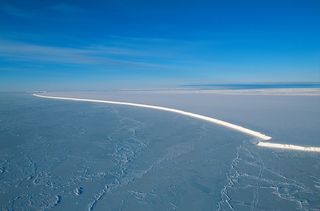Ancient Rocky Structure Found Beneath Antarctica. And It's Messing with the Ice.

An ancient rocky structure found at the heart of the Ross ice shelf helps determine where Antarctica's ice melts and where it stays firm and frozen.
The structure is an old tectonic boundary, probably formed during the birth of the Antarctic continent or shortly thereafter. According to new research published May 27 in the journal Nature Geoscience, this boundary protects the ice shelf's grounding line, the point at which it is thick enough to extend all the way to the sea floor. The geology created by the boundary keeps warm, melt-promoting ocean water away from that part of the shelf. But the ocean circulation driven by that same geology drives intense summer melt along the shelf's easterly edge.
"We could see that the geological boundary was making the seafloor on the East Antarctic side much deeper than the West, and that affects the way the ocean water circulates under the ice shelf," study leader Kirsty Tinto, a research scientist at Lamont-Doherty Earth Observatory at Columbia University, said in a statement. [Antarctica: The Ice-Covered Bottom of the World (Photos)]
The Ross Ice Shelf
The Ross ice shelf is an expanse of ice 185,000 square miles (480,000) square kilometers) in area and hundreds of feet thick. Ice flows onto the shelf from the land-based East and West Antarctic Ice Sheets. Currently, the ice shelf is stable, Tinto and her colleagues wrote in Nature Geoscience, but geological and marine records show that is has collapsed in the distant past.
To understand the dynamics of the ice sheet, Tinto and her colleagues used data from an airplane-based tool called IcePod, which holds instruments that collect information on ice-shelf thickness and structure as well as instruments that detect magnetic and gravitational anomalies from the rock underlying the ice shelf. Magnetic minerals, for instance, found in magma and other rocky material under Antarctica, can change the magnetic-field readings in those spots, while undersea topography can affect gravitational readings. With this data, the researchers reconstructed a map of the ice shelf and the rock underneath. [Photos: Diving Beneath Antarctica's Ross Ice Shelf]
They found a stark transition zone bisecting the ice sheet. If Antarctica were a wheel, the boundary would look a bit like a spoke, emanating from a spot a bit off-center. This transition zone is actually the line of demarcation between the geology of West Antarctica and East Antarctica. To the west, the rocks are a combination of sedimentary and magmatic, having formed from tectonic interactions, at the confluence of an oceanic and tectonic plate. East Antarctica is ancient continental material known as craton.
Geology's influence
The newly discovered tectonic boundary bisecting the Ross ice shelf matters because it helps shape the seafloor beneath the ice. To the east, the seafloor is deeper, at 2,198 feet (670 meters), on average. To the west, the average depth is 1,837 feet (560 m), on average.
Sign up for the Live Science daily newsletter now
Get the world’s most fascinating discoveries delivered straight to your inbox.
The researchers used a computer model to show how seawater circulates, given this new geologic knowledge. The good news is that the seafloor geometry keeps most warm ocean water away from the Ross ice shelf. Instead, an area of open sea called the Ross Shelf Polynya vents the warm, deep-ocean water, cooling it before it can flow beneath the ice shelf. But there is a lot of ice melt along the leading edge of the ice shelf (where it meets the sea), especially in the summer. The highest summer melt is near Ross Island, on the East Antarctic side.
So what does it all mean for a warming Antarctic? In the near future, the ice shelf's grounding line (the point at which it contacts the seafloor) should remain stable, at least in the face of moderate climate change, the researchers wrote. But variations in local climate will have a big impact on how fast the front edge of the ice shelf melts. These variations could include reductions in sea ice declines or cloud cover decreases, Laurie Padman, a senior scientist at Earth and Space Research in Oregon and study co-author, said in the statement.
"We found out that it's these local processes we need to understand to make sound predictions," Tinto said.
- Images of Melt: Earth's Vanishing Ice
- Collapsing Beauty: Image of Antarctica's Larsen Ice Shelf
- Album: Stunning Photos of Antarctic Ice
Originally published on Live Science.

Stephanie Pappas is a contributing writer for Live Science, covering topics ranging from geoscience to archaeology to the human brain and behavior. She was previously a senior writer for Live Science but is now a freelancer based in Denver, Colorado, and regularly contributes to Scientific American and The Monitor, the monthly magazine of the American Psychological Association. Stephanie received a bachelor's degree in psychology from the University of South Carolina and a graduate certificate in science communication from the University of California, Santa Cruz.
